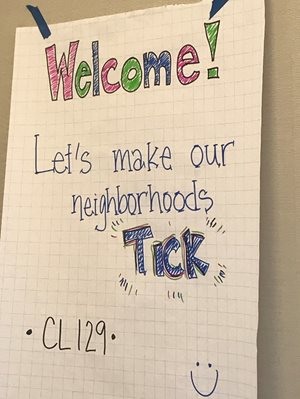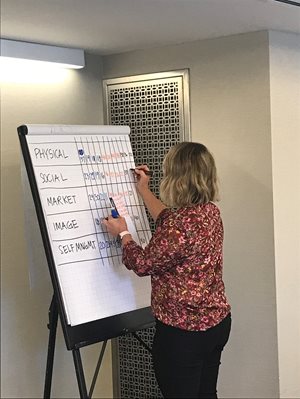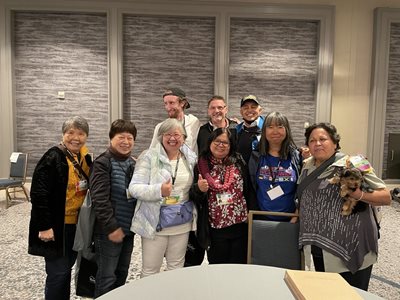Nearly 500 residents and affordable housing and community development staff from across the U.S., D.C. and Puerto Rico attended NeighborWorks America's Community Leadership Institute (CLI) last week to receive training, share ideas and learn how to make their voices heard.
During the training in San Francisco, California, residents also met in teams to brainstorm projects that they hope to institute over the next year. Ideas ranged from creating an employment toolkit to teaching neighbors how to make garden boxes. One team hopes to look at the prevention of drug use among young people. Another team plans to share the stories of a whole community in writing and in a theater production. NeighborWorks presents the organizations with grants to help fund those projects.
During the event, a part of NeighborWorks America's 45th anniverarry year, leaders also discussed accomplishments: new renter protections, a new group of interpreters ready to help the community and more.
accomplishments: new renter protections, a new group of interpreters ready to help the community and more.
This was the first CLI for Samantha Joseph, a community health specialist who came with the Codman Square resident leader group. Her takeaway? "Understanding the different ways of bringing community together to work on a common cause," she said.
Orlando Rivera, a single father to two children, hoped to expand his education and tools for leadership during the CLI. Rivera's leadership started when he moved to an apartment home owned by Way Finders after spending time in a family shelter. He became an integral part of the community, using his leadership and language skills to translate in Spanish and English for residents who needed it. He also works at Hope for Holyoke Recovery Center. Now a part of Way Finder's CLI team, Rivera said he is looking for more ways to help his community.
At NeighborWorks, leaders believe residents can find powerful solutions for their communities because they also know the challenges. Resident leadership was a key part of NeighborWorks' founding 45 years ago, inspired by the work of Dorothy Mae Richardson, a Black homeowner who, with her neighbors, brought business and government leaders to the table to address disinvestment and save their neighborhood. While Richardson herself had no formal training, NeighborWorks provides formal training through the Building Leaders, Building Communities program and through smaller regional leadership events. But the CLI is the largest training effort.
In a video that speaks to the impact of the CLI, which aired during the event,, Julie Porter of DreamKey Partners said, "So often, we are working in neighborhoods. But we want to be working for neighborhoods." Training community leaders is a pathway to doing that.
 From each session — individual classes and plenary sessions alike — came words of inspiration and examples of triumph over challenges.
From each session — individual classes and plenary sessions alike — came words of inspiration and examples of triumph over challenges.
"Feeling like you belong is important to your health," Romi Hall, NeighborWorks' director of Healthy Homes and Communities, explained in one class.
In another, this one on storytelling, instructor Patrick McNeal explained, "We're helping people tell their stories so they can tell someone else."
In a plenary session, attended by all participants, representatives of three San Francisco-based NeighborWorks network organizations talked about their work independently and with one another. Mission Economic Development Agency's Juan Diego Castro highlighted its Mission Neighborhood. Part of community development is figuring out where to start, he said, and not reinventing the wheel with each project. "Partnering is beneficial." After several projects with Chinatown CDC and Tenderloin Neighborhood Development Corp., the organization is now paying it forward, assisting other organizations.
Chinatown CDC's Executive Director Malcolm Yeung talked about progress getting families out of single room occupancy units and into larger spaces. At meetings, he said, people listen to him, not because of who he is but because of the residents he represents. It is the community, standing side by side that makes the difference.
Win Hoo Leung, who himself has received a Dorothy Richardson Award for Resident Leadership in 2011, is president of a community tenants association in Chinatown, bringing the group's numbers into the thousands. "In solidarity we work together, we fight for tenants' rights," he said through a translator, before giving advice on how to stay engaged in community development work. "You need to put your heart to the community. When you communicate with tenants, always talk to them truly." Sometimes, doing this type of community work can be frustrating. "But when you serve the community, you are fulfilled."
MEDA's Maria Gonzalez said another secret is not keeping the work and knowledge to yourself. "We pass it to the rest of the community members," she said.
Curtis Bradford, a community organizer with Tenderloin Neighborhood Development Corporation (TNDC), shared this sentiment: "We want to build resident leadership into everything we do. For me it's been transformational."
Bradford spoke from the podium about his time as a drug user and the homelessness he experienced before he found a place to live through TNDC. "It set me on a new path," he said. It's an amazing thing, "when you see someone find their voice, someone who's been oppressed or downtrodden — when they know their voice or story has power. When you teach someone to speak up you can never make them quiet again."Before he began working full time for the organization, Bradford went with a group of residents to a NeighborWorks CLI to get training and help build skills — and community. Now he is a leader, bringing groups of residents with him. "I expect you to be standing up here in a few years, to keep the cycle going," he told the audience.

From her seat, Janeth Daniels, a member of Bradford's project team who also experienced homelessness and found housing through the organization, nodded. "I want to be up there," she said.
Sarah Parmenter, director of community building for NeighborWorks America, reflected on the event. "I am so inspired by the many community leaders who took time away from their families, work and communities to further their own leadership development at this year's CLI," she said. "They came to San Francisco full of wisdom, energy and ideas and left with new connections and plans to bring their community visions to life. I look forward to hearing how they work with their neighbors to make their communities stronger, better places to live."

